Assessment 2: Developing Value in Healthcare - Cleveland Clinic
VerifiedAdded on 2022/12/29
|11
|2920
|20
Report
AI Summary
This report analyzes the Cleveland Clinic's healthcare model, focusing on its strategies for delivering high-value services, improving patient outcomes, and fostering innovation. The analysis includes an executive summary, background information on the clinic, its objectives, and the methods employed, such as case studies, optional analysis, and evidence-based design. The report highlights the Cleveland Clinic's approach to reshaping care delivery, prioritizing the patient, and rationalizing the health system. It recommends specific actions for New South Wales (NSW) hospitals, including reshaping healthcare structures, emphasizing wellness and patient experience, and incorporating technology. The report also discusses potential implementation challenges, such as socio-demographic factors and medical costs, and concludes by emphasizing the value of patient-centric care and the potential for adapting the Cleveland Clinic's model to improve healthcare in NSW.
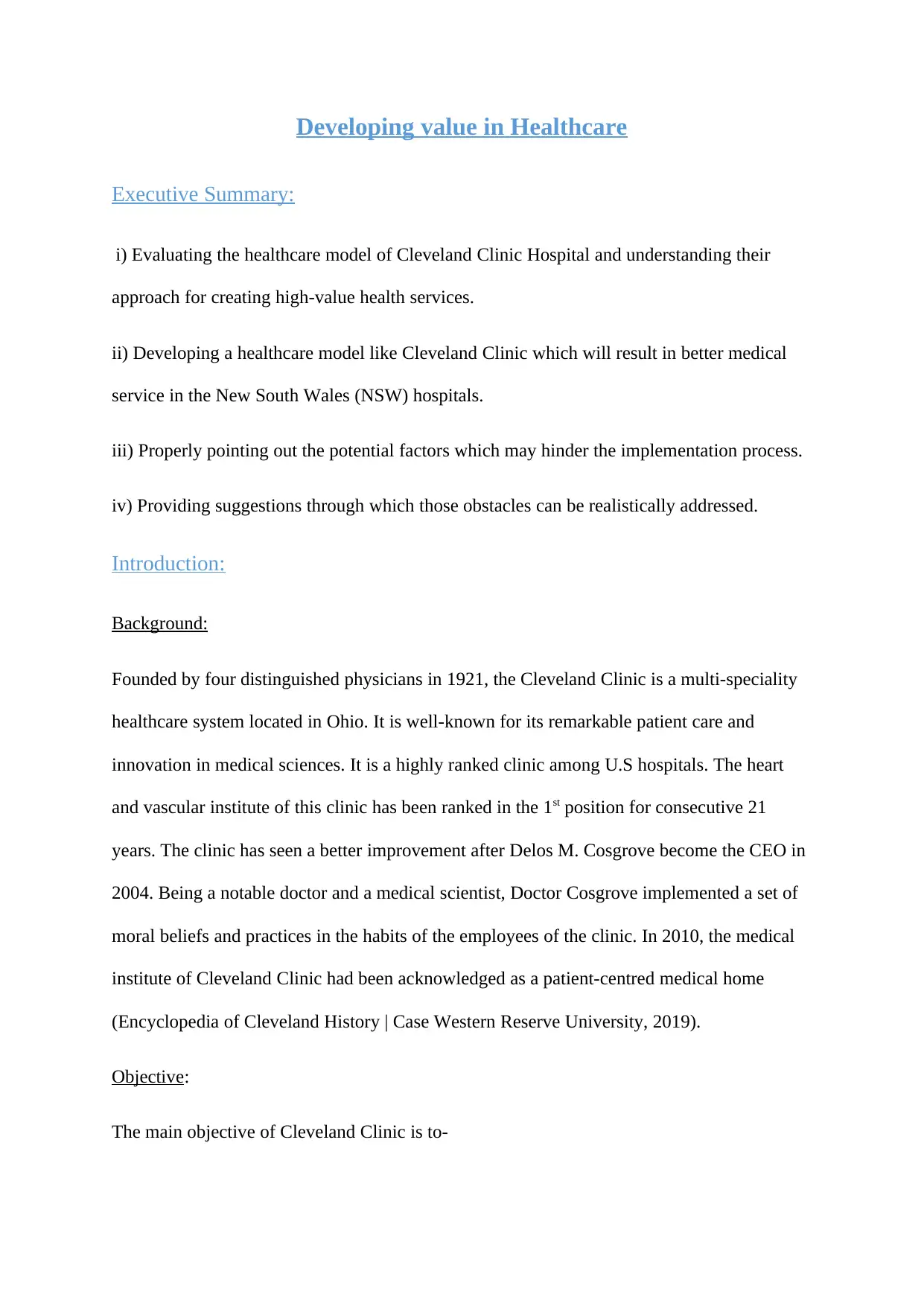
Developing value in Healthcare
Executive Summary:
i) Evaluating the healthcare model of Cleveland Clinic Hospital and understanding their
approach for creating high-value health services.
ii) Developing a healthcare model like Cleveland Clinic which will result in better medical
service in the New South Wales (NSW) hospitals.
iii) Properly pointing out the potential factors which may hinder the implementation process.
iv) Providing suggestions through which those obstacles can be realistically addressed.
Introduction:
Background:
Founded by four distinguished physicians in 1921, the Cleveland Clinic is a multi-speciality
healthcare system located in Ohio. It is well-known for its remarkable patient care and
innovation in medical sciences. It is a highly ranked clinic among U.S hospitals. The heart
and vascular institute of this clinic has been ranked in the 1st position for consecutive 21
years. The clinic has seen a better improvement after Delos M. Cosgrove become the CEO in
2004. Being a notable doctor and a medical scientist, Doctor Cosgrove implemented a set of
moral beliefs and practices in the habits of the employees of the clinic. In 2010, the medical
institute of Cleveland Clinic had been acknowledged as a patient-centred medical home
(Encyclopedia of Cleveland History | Case Western Reserve University, 2019).
Objective:
The main objective of Cleveland Clinic is to-
Executive Summary:
i) Evaluating the healthcare model of Cleveland Clinic Hospital and understanding their
approach for creating high-value health services.
ii) Developing a healthcare model like Cleveland Clinic which will result in better medical
service in the New South Wales (NSW) hospitals.
iii) Properly pointing out the potential factors which may hinder the implementation process.
iv) Providing suggestions through which those obstacles can be realistically addressed.
Introduction:
Background:
Founded by four distinguished physicians in 1921, the Cleveland Clinic is a multi-speciality
healthcare system located in Ohio. It is well-known for its remarkable patient care and
innovation in medical sciences. It is a highly ranked clinic among U.S hospitals. The heart
and vascular institute of this clinic has been ranked in the 1st position for consecutive 21
years. The clinic has seen a better improvement after Delos M. Cosgrove become the CEO in
2004. Being a notable doctor and a medical scientist, Doctor Cosgrove implemented a set of
moral beliefs and practices in the habits of the employees of the clinic. In 2010, the medical
institute of Cleveland Clinic had been acknowledged as a patient-centred medical home
(Encyclopedia of Cleveland History | Case Western Reserve University, 2019).
Objective:
The main objective of Cleveland Clinic is to-
Paraphrase This Document
Need a fresh take? Get an instant paraphrase of this document with our AI Paraphraser
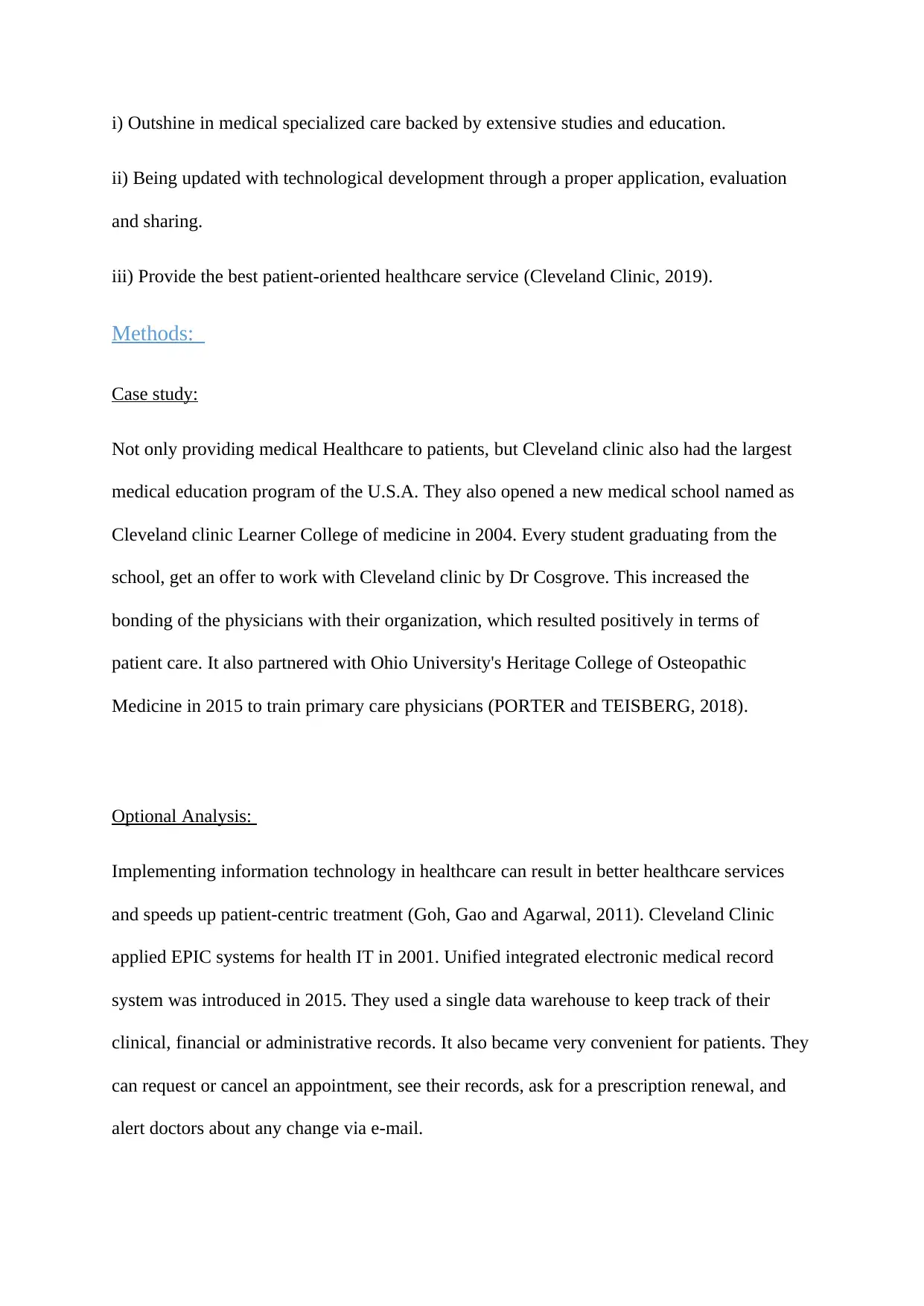
i) Outshine in medical specialized care backed by extensive studies and education.
ii) Being updated with technological development through a proper application, evaluation
and sharing.
iii) Provide the best patient-oriented healthcare service (Cleveland Clinic, 2019).
Methods:
Case study:
Not only providing medical Healthcare to patients, but Cleveland clinic also had the largest
medical education program of the U.S.A. They also opened a new medical school named as
Cleveland clinic Learner College of medicine in 2004. Every student graduating from the
school, get an offer to work with Cleveland clinic by Dr Cosgrove. This increased the
bonding of the physicians with their organization, which resulted positively in terms of
patient care. It also partnered with Ohio University's Heritage College of Osteopathic
Medicine in 2015 to train primary care physicians (PORTER and TEISBERG, 2018).
Optional Analysis:
Implementing information technology in healthcare can result in better healthcare services
and speeds up patient-centric treatment (Goh, Gao and Agarwal, 2011). Cleveland Clinic
applied EPIC systems for health IT in 2001. Unified integrated electronic medical record
system was introduced in 2015. They used a single data warehouse to keep track of their
clinical, financial or administrative records. It also became very convenient for patients. They
can request or cancel an appointment, see their records, ask for a prescription renewal, and
alert doctors about any change via e-mail.
ii) Being updated with technological development through a proper application, evaluation
and sharing.
iii) Provide the best patient-oriented healthcare service (Cleveland Clinic, 2019).
Methods:
Case study:
Not only providing medical Healthcare to patients, but Cleveland clinic also had the largest
medical education program of the U.S.A. They also opened a new medical school named as
Cleveland clinic Learner College of medicine in 2004. Every student graduating from the
school, get an offer to work with Cleveland clinic by Dr Cosgrove. This increased the
bonding of the physicians with their organization, which resulted positively in terms of
patient care. It also partnered with Ohio University's Heritage College of Osteopathic
Medicine in 2015 to train primary care physicians (PORTER and TEISBERG, 2018).
Optional Analysis:
Implementing information technology in healthcare can result in better healthcare services
and speeds up patient-centric treatment (Goh, Gao and Agarwal, 2011). Cleveland Clinic
applied EPIC systems for health IT in 2001. Unified integrated electronic medical record
system was introduced in 2015. They used a single data warehouse to keep track of their
clinical, financial or administrative records. It also became very convenient for patients. They
can request or cancel an appointment, see their records, ask for a prescription renewal, and
alert doctors about any change via e-mail.
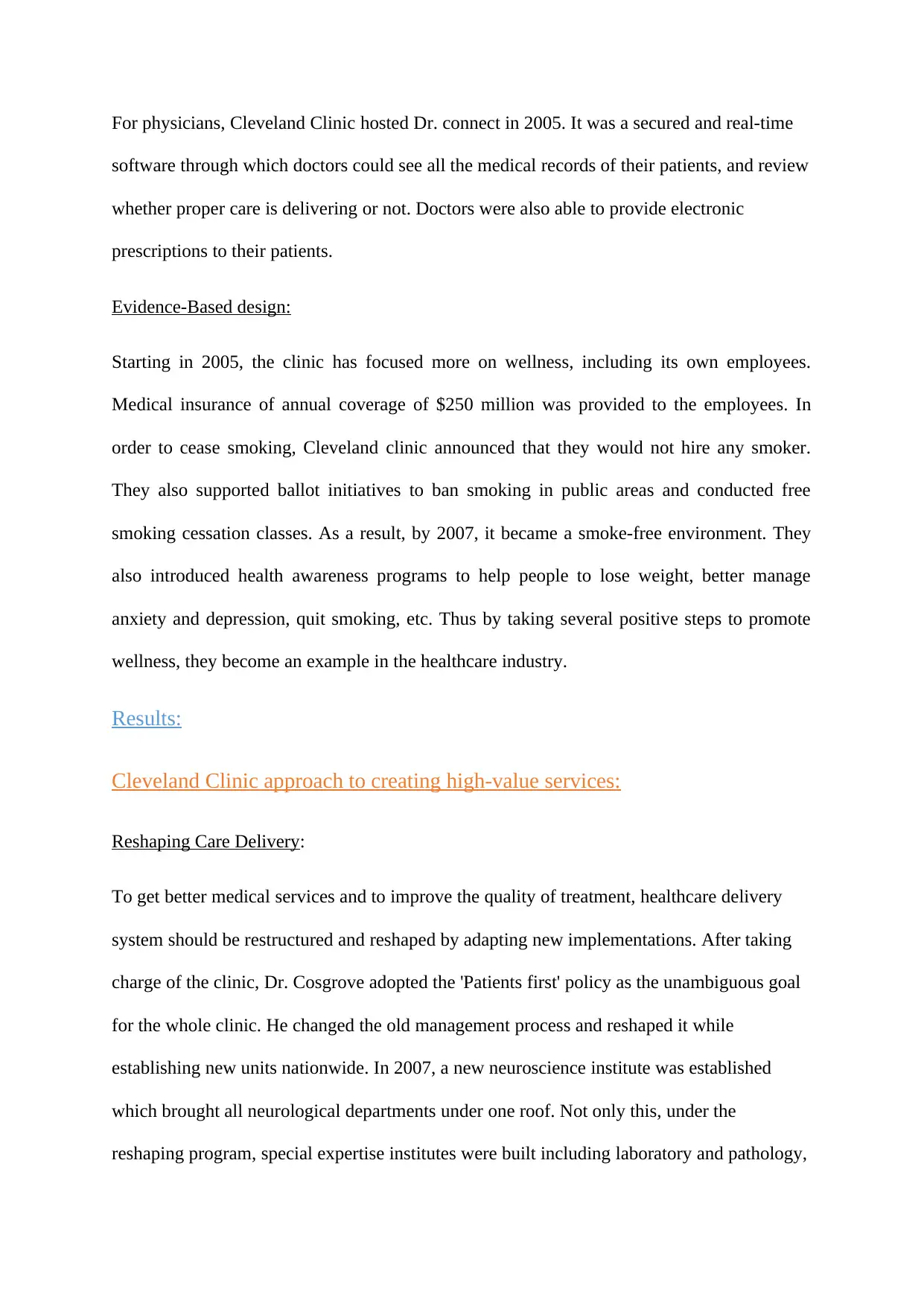
For physicians, Cleveland Clinic hosted Dr. connect in 2005. It was a secured and real-time
software through which doctors could see all the medical records of their patients, and review
whether proper care is delivering or not. Doctors were also able to provide electronic
prescriptions to their patients.
Evidence-Based design:
Starting in 2005, the clinic has focused more on wellness, including its own employees.
Medical insurance of annual coverage of $250 million was provided to the employees. In
order to cease smoking, Cleveland clinic announced that they would not hire any smoker.
They also supported ballot initiatives to ban smoking in public areas and conducted free
smoking cessation classes. As a result, by 2007, it became a smoke-free environment. They
also introduced health awareness programs to help people to lose weight, better manage
anxiety and depression, quit smoking, etc. Thus by taking several positive steps to promote
wellness, they become an example in the healthcare industry.
Results:
Cleveland Clinic approach to creating high-value services:
Reshaping Care Delivery:
To get better medical services and to improve the quality of treatment, healthcare delivery
system should be restructured and reshaped by adapting new implementations. After taking
charge of the clinic, Dr. Cosgrove adopted the 'Patients first' policy as the unambiguous goal
for the whole clinic. He changed the old management process and reshaped it while
establishing new units nationwide. In 2007, a new neuroscience institute was established
which brought all neurological departments under one roof. Not only this, under the
reshaping program, special expertise institutes were built including laboratory and pathology,
software through which doctors could see all the medical records of their patients, and review
whether proper care is delivering or not. Doctors were also able to provide electronic
prescriptions to their patients.
Evidence-Based design:
Starting in 2005, the clinic has focused more on wellness, including its own employees.
Medical insurance of annual coverage of $250 million was provided to the employees. In
order to cease smoking, Cleveland clinic announced that they would not hire any smoker.
They also supported ballot initiatives to ban smoking in public areas and conducted free
smoking cessation classes. As a result, by 2007, it became a smoke-free environment. They
also introduced health awareness programs to help people to lose weight, better manage
anxiety and depression, quit smoking, etc. Thus by taking several positive steps to promote
wellness, they become an example in the healthcare industry.
Results:
Cleveland Clinic approach to creating high-value services:
Reshaping Care Delivery:
To get better medical services and to improve the quality of treatment, healthcare delivery
system should be restructured and reshaped by adapting new implementations. After taking
charge of the clinic, Dr. Cosgrove adopted the 'Patients first' policy as the unambiguous goal
for the whole clinic. He changed the old management process and reshaped it while
establishing new units nationwide. In 2007, a new neuroscience institute was established
which brought all neurological departments under one roof. Not only this, under the
reshaping program, special expertise institutes were built including laboratory and pathology,
⊘ This is a preview!⊘
Do you want full access?
Subscribe today to unlock all pages.

Trusted by 1+ million students worldwide
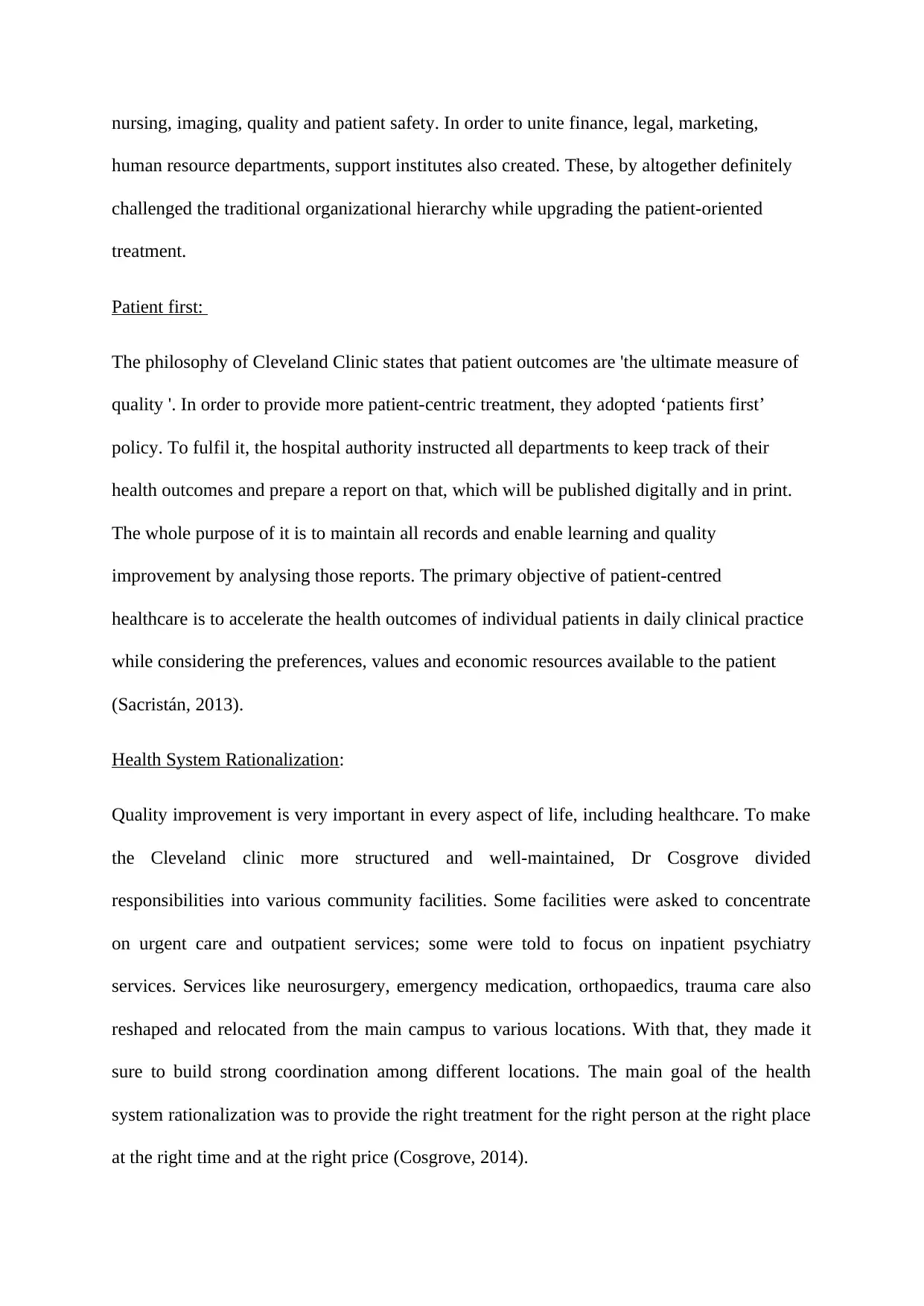
nursing, imaging, quality and patient safety. In order to unite finance, legal, marketing,
human resource departments, support institutes also created. These, by altogether definitely
challenged the traditional organizational hierarchy while upgrading the patient-oriented
treatment.
Patient first:
The philosophy of Cleveland Clinic states that patient outcomes are 'the ultimate measure of
quality '. In order to provide more patient-centric treatment, they adopted ‘patients first’
policy. To fulfil it, the hospital authority instructed all departments to keep track of their
health outcomes and prepare a report on that, which will be published digitally and in print.
The whole purpose of it is to maintain all records and enable learning and quality
improvement by analysing those reports. The primary objective of patient-centred
healthcare is to accelerate the health outcomes of individual patients in daily clinical practice
while considering the preferences, values and economic resources available to the patient
(Sacristán, 2013).
Health System Rationalization:
Quality improvement is very important in every aspect of life, including healthcare. To make
the Cleveland clinic more structured and well-maintained, Dr Cosgrove divided
responsibilities into various community facilities. Some facilities were asked to concentrate
on urgent care and outpatient services; some were told to focus on inpatient psychiatry
services. Services like neurosurgery, emergency medication, orthopaedics, trauma care also
reshaped and relocated from the main campus to various locations. With that, they made it
sure to build strong coordination among different locations. The main goal of the health
system rationalization was to provide the right treatment for the right person at the right place
at the right time and at the right price (Cosgrove, 2014).
human resource departments, support institutes also created. These, by altogether definitely
challenged the traditional organizational hierarchy while upgrading the patient-oriented
treatment.
Patient first:
The philosophy of Cleveland Clinic states that patient outcomes are 'the ultimate measure of
quality '. In order to provide more patient-centric treatment, they adopted ‘patients first’
policy. To fulfil it, the hospital authority instructed all departments to keep track of their
health outcomes and prepare a report on that, which will be published digitally and in print.
The whole purpose of it is to maintain all records and enable learning and quality
improvement by analysing those reports. The primary objective of patient-centred
healthcare is to accelerate the health outcomes of individual patients in daily clinical practice
while considering the preferences, values and economic resources available to the patient
(Sacristán, 2013).
Health System Rationalization:
Quality improvement is very important in every aspect of life, including healthcare. To make
the Cleveland clinic more structured and well-maintained, Dr Cosgrove divided
responsibilities into various community facilities. Some facilities were asked to concentrate
on urgent care and outpatient services; some were told to focus on inpatient psychiatry
services. Services like neurosurgery, emergency medication, orthopaedics, trauma care also
reshaped and relocated from the main campus to various locations. With that, they made it
sure to build strong coordination among different locations. The main goal of the health
system rationalization was to provide the right treatment for the right person at the right place
at the right time and at the right price (Cosgrove, 2014).
Paraphrase This Document
Need a fresh take? Get an instant paraphrase of this document with our AI Paraphraser
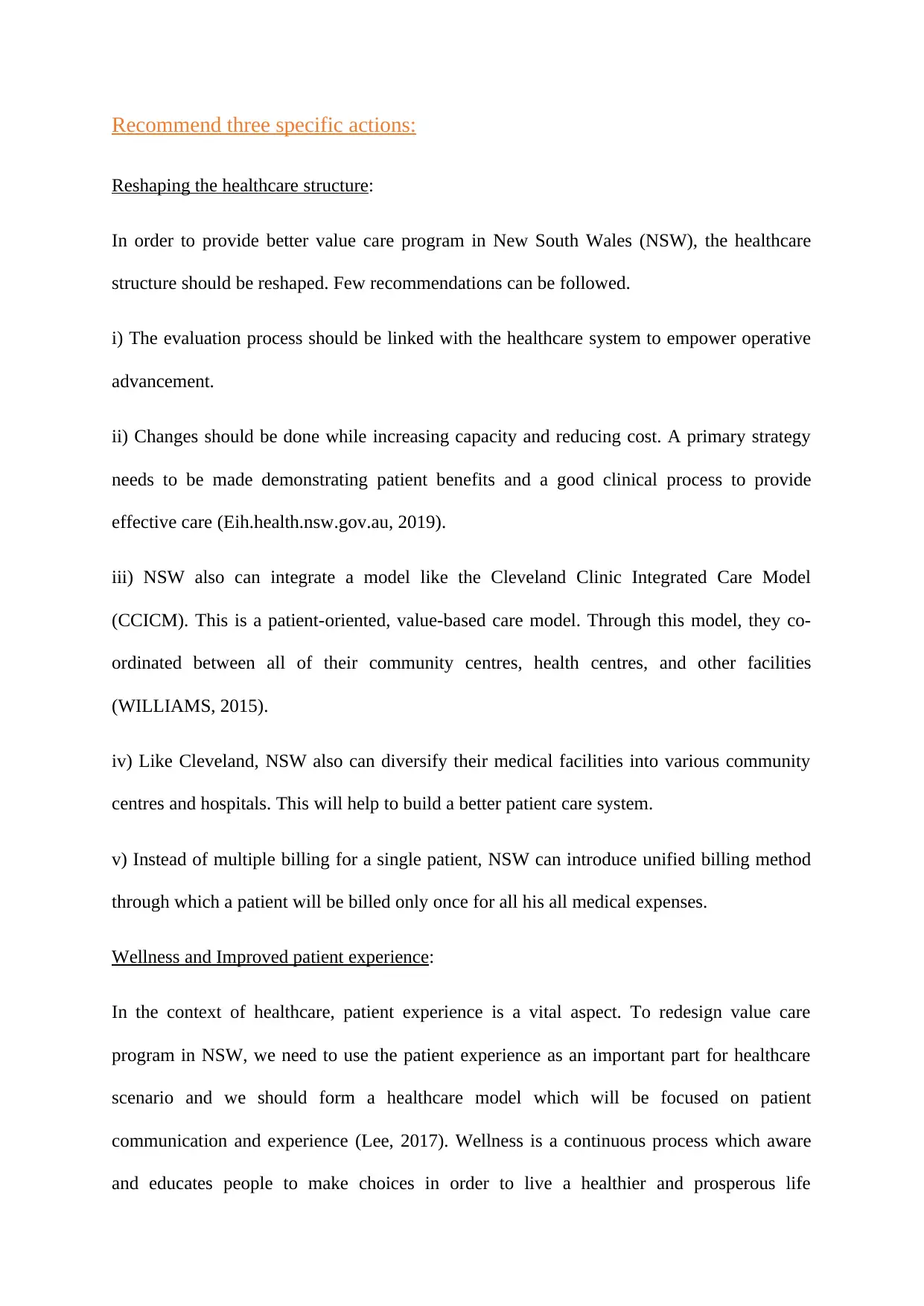
Recommend three specific actions:
Reshaping the healthcare structure:
In order to provide better value care program in New South Wales (NSW), the healthcare
structure should be reshaped. Few recommendations can be followed.
i) The evaluation process should be linked with the healthcare system to empower operative
advancement.
ii) Changes should be done while increasing capacity and reducing cost. A primary strategy
needs to be made demonstrating patient benefits and a good clinical process to provide
effective care (Eih.health.nsw.gov.au, 2019).
iii) NSW also can integrate a model like the Cleveland Clinic Integrated Care Model
(CCICM). This is a patient-oriented, value-based care model. Through this model, they co-
ordinated between all of their community centres, health centres, and other facilities
(WILLIAMS, 2015).
iv) Like Cleveland, NSW also can diversify their medical facilities into various community
centres and hospitals. This will help to build a better patient care system.
v) Instead of multiple billing for a single patient, NSW can introduce unified billing method
through which a patient will be billed only once for all his all medical expenses.
Wellness and Improved patient experience:
In the context of healthcare, patient experience is a vital aspect. To redesign value care
program in NSW, we need to use the patient experience as an important part for healthcare
scenario and we should form a healthcare model which will be focused on patient
communication and experience (Lee, 2017). Wellness is a continuous process which aware
and educates people to make choices in order to live a healthier and prosperous life
Reshaping the healthcare structure:
In order to provide better value care program in New South Wales (NSW), the healthcare
structure should be reshaped. Few recommendations can be followed.
i) The evaluation process should be linked with the healthcare system to empower operative
advancement.
ii) Changes should be done while increasing capacity and reducing cost. A primary strategy
needs to be made demonstrating patient benefits and a good clinical process to provide
effective care (Eih.health.nsw.gov.au, 2019).
iii) NSW also can integrate a model like the Cleveland Clinic Integrated Care Model
(CCICM). This is a patient-oriented, value-based care model. Through this model, they co-
ordinated between all of their community centres, health centres, and other facilities
(WILLIAMS, 2015).
iv) Like Cleveland, NSW also can diversify their medical facilities into various community
centres and hospitals. This will help to build a better patient care system.
v) Instead of multiple billing for a single patient, NSW can introduce unified billing method
through which a patient will be billed only once for all his all medical expenses.
Wellness and Improved patient experience:
In the context of healthcare, patient experience is a vital aspect. To redesign value care
program in NSW, we need to use the patient experience as an important part for healthcare
scenario and we should form a healthcare model which will be focused on patient
communication and experience (Lee, 2017). Wellness is a continuous process which aware
and educates people to make choices in order to live a healthier and prosperous life
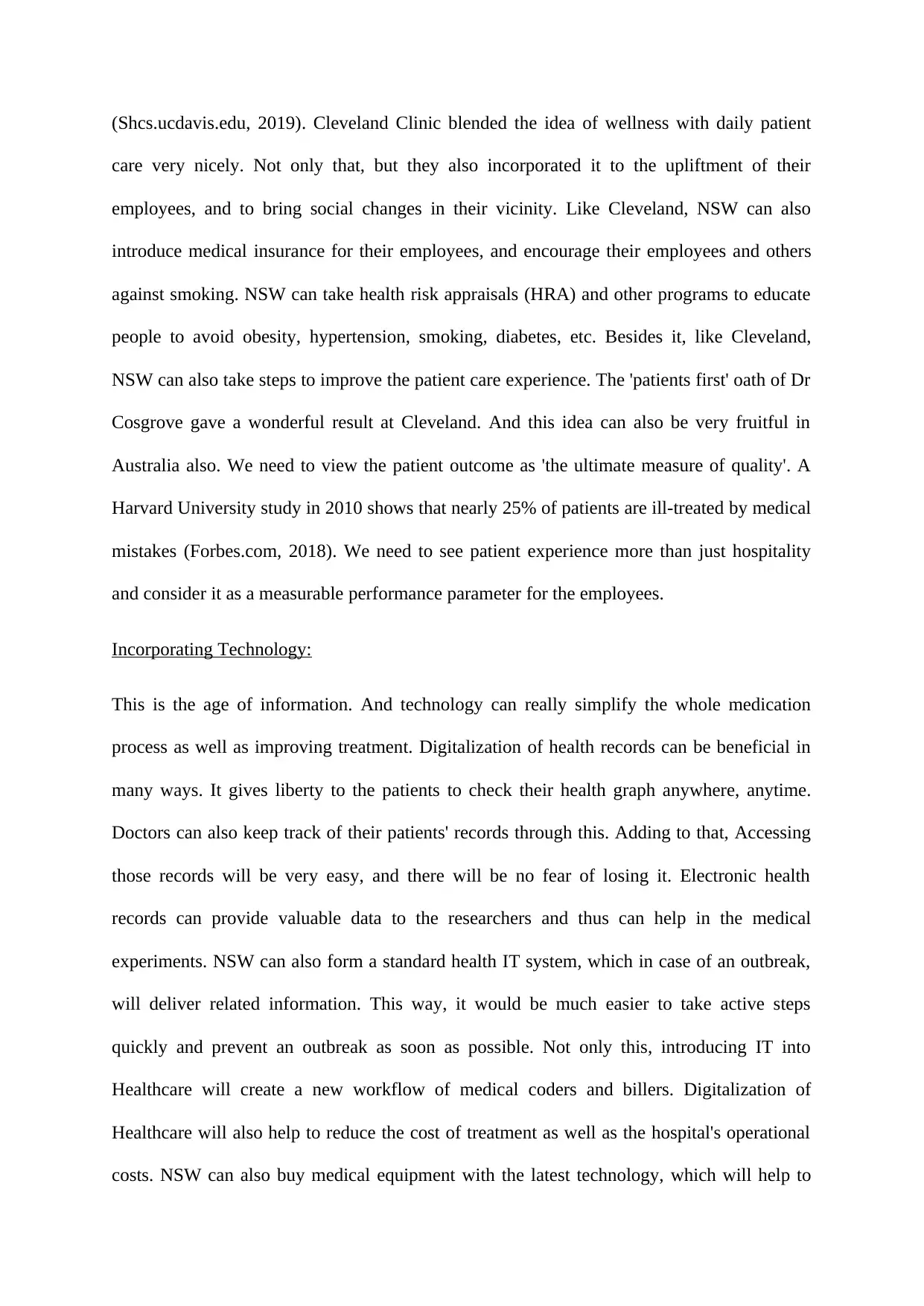
(Shcs.ucdavis.edu, 2019). Cleveland Clinic blended the idea of wellness with daily patient
care very nicely. Not only that, but they also incorporated it to the upliftment of their
employees, and to bring social changes in their vicinity. Like Cleveland, NSW can also
introduce medical insurance for their employees, and encourage their employees and others
against smoking. NSW can take health risk appraisals (HRA) and other programs to educate
people to avoid obesity, hypertension, smoking, diabetes, etc. Besides it, like Cleveland,
NSW can also take steps to improve the patient care experience. The 'patients first' oath of Dr
Cosgrove gave a wonderful result at Cleveland. And this idea can also be very fruitful in
Australia also. We need to view the patient outcome as 'the ultimate measure of quality'. A
Harvard University study in 2010 shows that nearly 25% of patients are ill-treated by medical
mistakes (Forbes.com, 2018). We need to see patient experience more than just hospitality
and consider it as a measurable performance parameter for the employees.
Incorporating Technology:
This is the age of information. And technology can really simplify the whole medication
process as well as improving treatment. Digitalization of health records can be beneficial in
many ways. It gives liberty to the patients to check their health graph anywhere, anytime.
Doctors can also keep track of their patients' records through this. Adding to that, Accessing
those records will be very easy, and there will be no fear of losing it. Electronic health
records can provide valuable data to the researchers and thus can help in the medical
experiments. NSW can also form a standard health IT system, which in case of an outbreak,
will deliver related information. This way, it would be much easier to take active steps
quickly and prevent an outbreak as soon as possible. Not only this, introducing IT into
Healthcare will create a new workflow of medical coders and billers. Digitalization of
Healthcare will also help to reduce the cost of treatment as well as the hospital's operational
costs. NSW can also buy medical equipment with the latest technology, which will help to
care very nicely. Not only that, but they also incorporated it to the upliftment of their
employees, and to bring social changes in their vicinity. Like Cleveland, NSW can also
introduce medical insurance for their employees, and encourage their employees and others
against smoking. NSW can take health risk appraisals (HRA) and other programs to educate
people to avoid obesity, hypertension, smoking, diabetes, etc. Besides it, like Cleveland,
NSW can also take steps to improve the patient care experience. The 'patients first' oath of Dr
Cosgrove gave a wonderful result at Cleveland. And this idea can also be very fruitful in
Australia also. We need to view the patient outcome as 'the ultimate measure of quality'. A
Harvard University study in 2010 shows that nearly 25% of patients are ill-treated by medical
mistakes (Forbes.com, 2018). We need to see patient experience more than just hospitality
and consider it as a measurable performance parameter for the employees.
Incorporating Technology:
This is the age of information. And technology can really simplify the whole medication
process as well as improving treatment. Digitalization of health records can be beneficial in
many ways. It gives liberty to the patients to check their health graph anywhere, anytime.
Doctors can also keep track of their patients' records through this. Adding to that, Accessing
those records will be very easy, and there will be no fear of losing it. Electronic health
records can provide valuable data to the researchers and thus can help in the medical
experiments. NSW can also form a standard health IT system, which in case of an outbreak,
will deliver related information. This way, it would be much easier to take active steps
quickly and prevent an outbreak as soon as possible. Not only this, introducing IT into
Healthcare will create a new workflow of medical coders and billers. Digitalization of
Healthcare will also help to reduce the cost of treatment as well as the hospital's operational
costs. NSW can also buy medical equipment with the latest technology, which will help to
⊘ This is a preview!⊘
Do you want full access?
Subscribe today to unlock all pages.

Trusted by 1+ million students worldwide
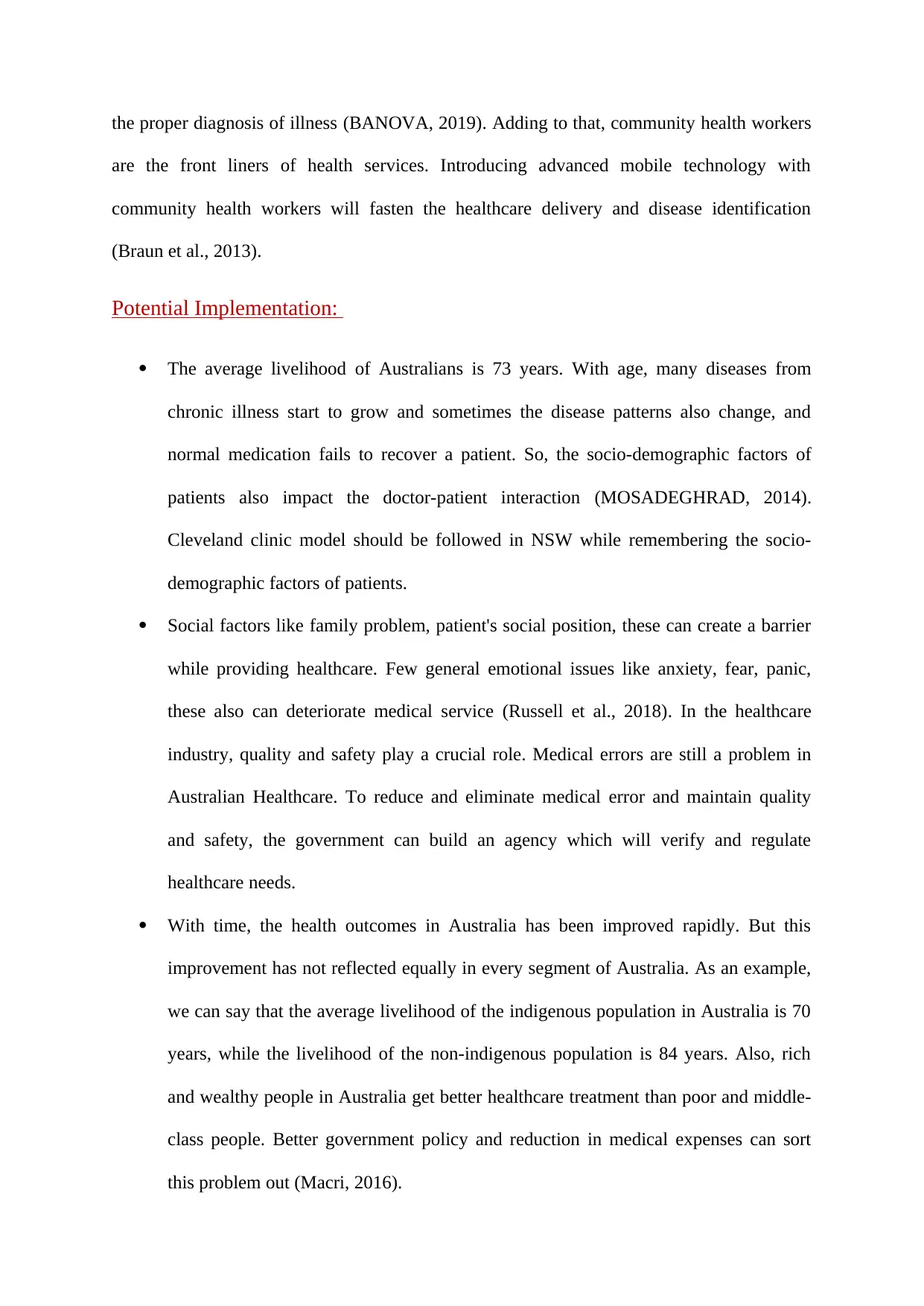
the proper diagnosis of illness (BANOVA, 2019). Adding to that, community health workers
are the front liners of health services. Introducing advanced mobile technology with
community health workers will fasten the healthcare delivery and disease identification
(Braun et al., 2013).
Potential Implementation:
The average livelihood of Australians is 73 years. With age, many diseases from
chronic illness start to grow and sometimes the disease patterns also change, and
normal medication fails to recover a patient. So, the socio-demographic factors of
patients also impact the doctor-patient interaction (MOSADEGHRAD, 2014).
Cleveland clinic model should be followed in NSW while remembering the socio-
demographic factors of patients.
Social factors like family problem, patient's social position, these can create a barrier
while providing healthcare. Few general emotional issues like anxiety, fear, panic,
these also can deteriorate medical service (Russell et al., 2018). In the healthcare
industry, quality and safety play a crucial role. Medical errors are still a problem in
Australian Healthcare. To reduce and eliminate medical error and maintain quality
and safety, the government can build an agency which will verify and regulate
healthcare needs.
With time, the health outcomes in Australia has been improved rapidly. But this
improvement has not reflected equally in every segment of Australia. As an example,
we can say that the average livelihood of the indigenous population in Australia is 70
years, while the livelihood of the non-indigenous population is 84 years. Also, rich
and wealthy people in Australia get better healthcare treatment than poor and middle-
class people. Better government policy and reduction in medical expenses can sort
this problem out (Macri, 2016).
are the front liners of health services. Introducing advanced mobile technology with
community health workers will fasten the healthcare delivery and disease identification
(Braun et al., 2013).
Potential Implementation:
The average livelihood of Australians is 73 years. With age, many diseases from
chronic illness start to grow and sometimes the disease patterns also change, and
normal medication fails to recover a patient. So, the socio-demographic factors of
patients also impact the doctor-patient interaction (MOSADEGHRAD, 2014).
Cleveland clinic model should be followed in NSW while remembering the socio-
demographic factors of patients.
Social factors like family problem, patient's social position, these can create a barrier
while providing healthcare. Few general emotional issues like anxiety, fear, panic,
these also can deteriorate medical service (Russell et al., 2018). In the healthcare
industry, quality and safety play a crucial role. Medical errors are still a problem in
Australian Healthcare. To reduce and eliminate medical error and maintain quality
and safety, the government can build an agency which will verify and regulate
healthcare needs.
With time, the health outcomes in Australia has been improved rapidly. But this
improvement has not reflected equally in every segment of Australia. As an example,
we can say that the average livelihood of the indigenous population in Australia is 70
years, while the livelihood of the non-indigenous population is 84 years. Also, rich
and wealthy people in Australia get better healthcare treatment than poor and middle-
class people. Better government policy and reduction in medical expenses can sort
this problem out (Macri, 2016).
Paraphrase This Document
Need a fresh take? Get an instant paraphrase of this document with our AI Paraphraser
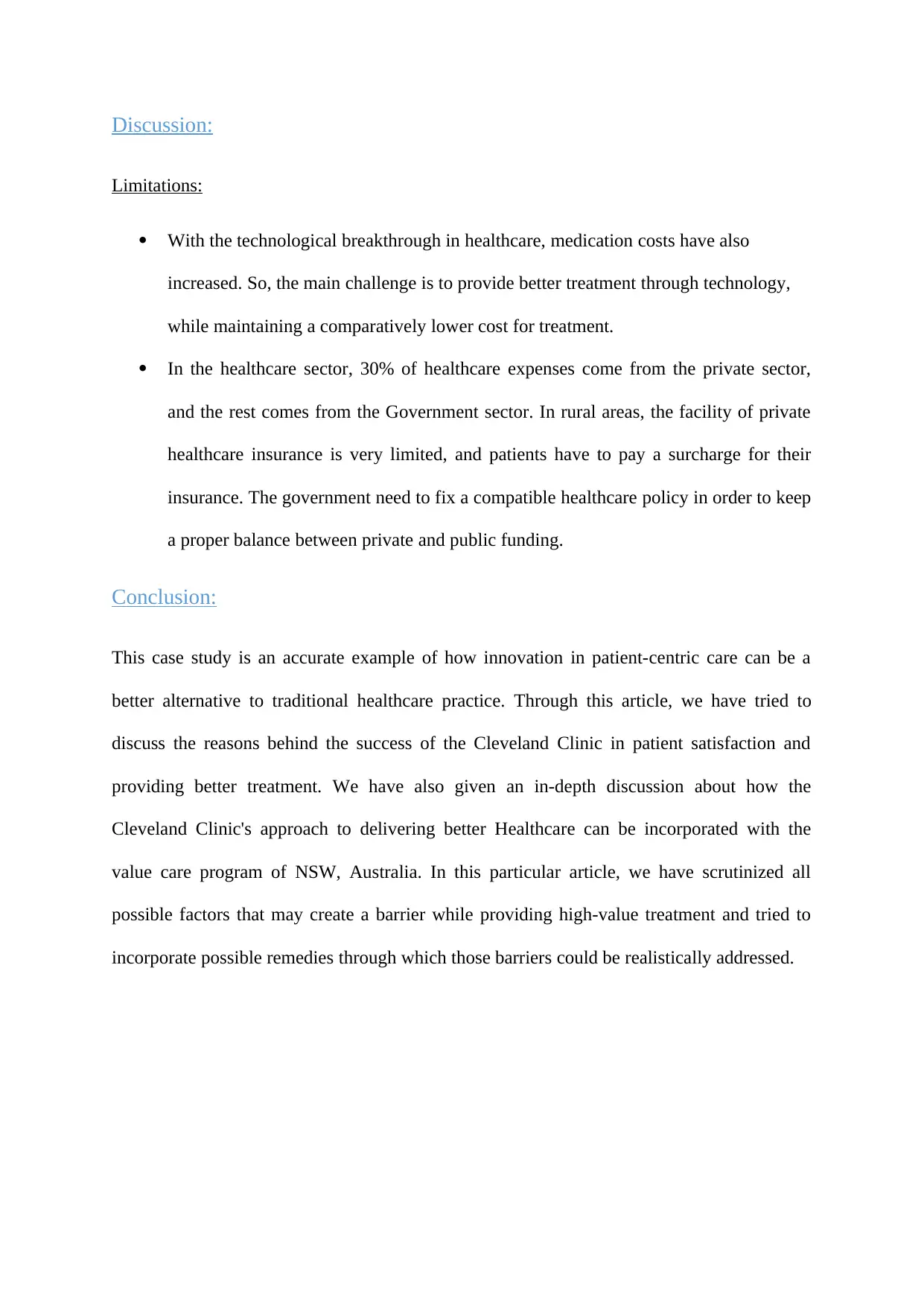
Discussion:
Limitations:
With the technological breakthrough in healthcare, medication costs have also
increased. So, the main challenge is to provide better treatment through technology,
while maintaining a comparatively lower cost for treatment.
In the healthcare sector, 30% of healthcare expenses come from the private sector,
and the rest comes from the Government sector. In rural areas, the facility of private
healthcare insurance is very limited, and patients have to pay a surcharge for their
insurance. The government need to fix a compatible healthcare policy in order to keep
a proper balance between private and public funding.
Conclusion:
This case study is an accurate example of how innovation in patient-centric care can be a
better alternative to traditional healthcare practice. Through this article, we have tried to
discuss the reasons behind the success of the Cleveland Clinic in patient satisfaction and
providing better treatment. We have also given an in-depth discussion about how the
Cleveland Clinic's approach to delivering better Healthcare can be incorporated with the
value care program of NSW, Australia. In this particular article, we have scrutinized all
possible factors that may create a barrier while providing high-value treatment and tried to
incorporate possible remedies through which those barriers could be realistically addressed.
Limitations:
With the technological breakthrough in healthcare, medication costs have also
increased. So, the main challenge is to provide better treatment through technology,
while maintaining a comparatively lower cost for treatment.
In the healthcare sector, 30% of healthcare expenses come from the private sector,
and the rest comes from the Government sector. In rural areas, the facility of private
healthcare insurance is very limited, and patients have to pay a surcharge for their
insurance. The government need to fix a compatible healthcare policy in order to keep
a proper balance between private and public funding.
Conclusion:
This case study is an accurate example of how innovation in patient-centric care can be a
better alternative to traditional healthcare practice. Through this article, we have tried to
discuss the reasons behind the success of the Cleveland Clinic in patient satisfaction and
providing better treatment. We have also given an in-depth discussion about how the
Cleveland Clinic's approach to delivering better Healthcare can be incorporated with the
value care program of NSW, Australia. In this particular article, we have scrutinized all
possible factors that may create a barrier while providing high-value treatment and tried to
incorporate possible remedies through which those barriers could be realistically addressed.
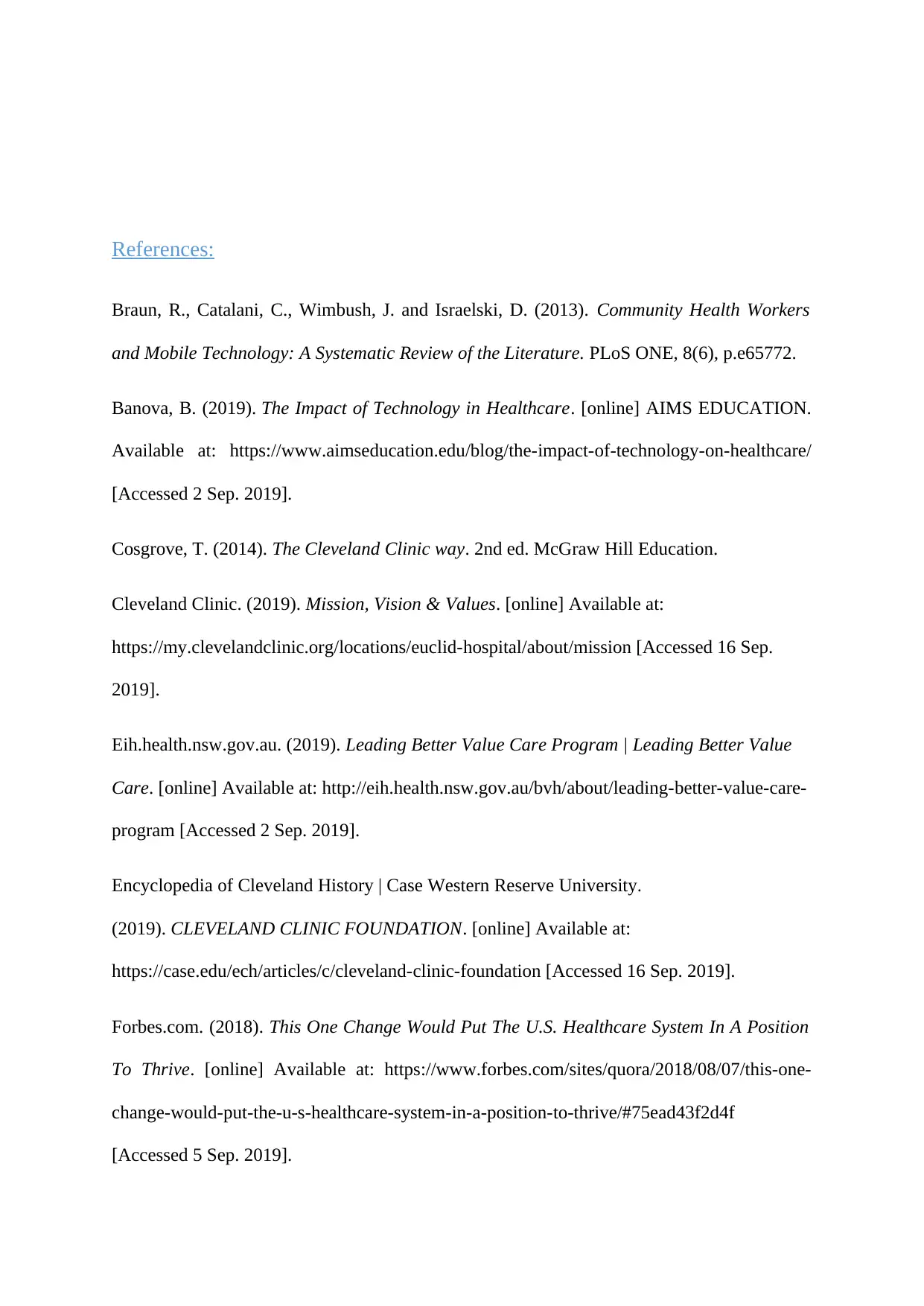
References:
Braun, R., Catalani, C., Wimbush, J. and Israelski, D. (2013). Community Health Workers
and Mobile Technology: A Systematic Review of the Literature. PLoS ONE, 8(6), p.e65772.
Banova, B. (2019). The Impact of Technology in Healthcare. [online] AIMS EDUCATION.
Available at: https://www.aimseducation.edu/blog/the-impact-of-technology-on-healthcare/
[Accessed 2 Sep. 2019].
Cosgrove, T. (2014). The Cleveland Clinic way. 2nd ed. McGraw Hill Education.
Cleveland Clinic. (2019). Mission, Vision & Values. [online] Available at:
https://my.clevelandclinic.org/locations/euclid-hospital/about/mission [Accessed 16 Sep.
2019].
Eih.health.nsw.gov.au. (2019). Leading Better Value Care Program | Leading Better Value
Care. [online] Available at: http://eih.health.nsw.gov.au/bvh/about/leading-better-value-care-
program [Accessed 2 Sep. 2019].
Encyclopedia of Cleveland History | Case Western Reserve University.
(2019). CLEVELAND CLINIC FOUNDATION. [online] Available at:
https://case.edu/ech/articles/c/cleveland-clinic-foundation [Accessed 16 Sep. 2019].
Forbes.com. (2018). This One Change Would Put The U.S. Healthcare System In A Position
To Thrive. [online] Available at: https://www.forbes.com/sites/quora/2018/08/07/this-one-
change-would-put-the-u-s-healthcare-system-in-a-position-to-thrive/#75ead43f2d4f
[Accessed 5 Sep. 2019].
Braun, R., Catalani, C., Wimbush, J. and Israelski, D. (2013). Community Health Workers
and Mobile Technology: A Systematic Review of the Literature. PLoS ONE, 8(6), p.e65772.
Banova, B. (2019). The Impact of Technology in Healthcare. [online] AIMS EDUCATION.
Available at: https://www.aimseducation.edu/blog/the-impact-of-technology-on-healthcare/
[Accessed 2 Sep. 2019].
Cosgrove, T. (2014). The Cleveland Clinic way. 2nd ed. McGraw Hill Education.
Cleveland Clinic. (2019). Mission, Vision & Values. [online] Available at:
https://my.clevelandclinic.org/locations/euclid-hospital/about/mission [Accessed 16 Sep.
2019].
Eih.health.nsw.gov.au. (2019). Leading Better Value Care Program | Leading Better Value
Care. [online] Available at: http://eih.health.nsw.gov.au/bvh/about/leading-better-value-care-
program [Accessed 2 Sep. 2019].
Encyclopedia of Cleveland History | Case Western Reserve University.
(2019). CLEVELAND CLINIC FOUNDATION. [online] Available at:
https://case.edu/ech/articles/c/cleveland-clinic-foundation [Accessed 16 Sep. 2019].
Forbes.com. (2018). This One Change Would Put The U.S. Healthcare System In A Position
To Thrive. [online] Available at: https://www.forbes.com/sites/quora/2018/08/07/this-one-
change-would-put-the-u-s-healthcare-system-in-a-position-to-thrive/#75ead43f2d4f
[Accessed 5 Sep. 2019].
⊘ This is a preview!⊘
Do you want full access?
Subscribe today to unlock all pages.

Trusted by 1+ million students worldwide
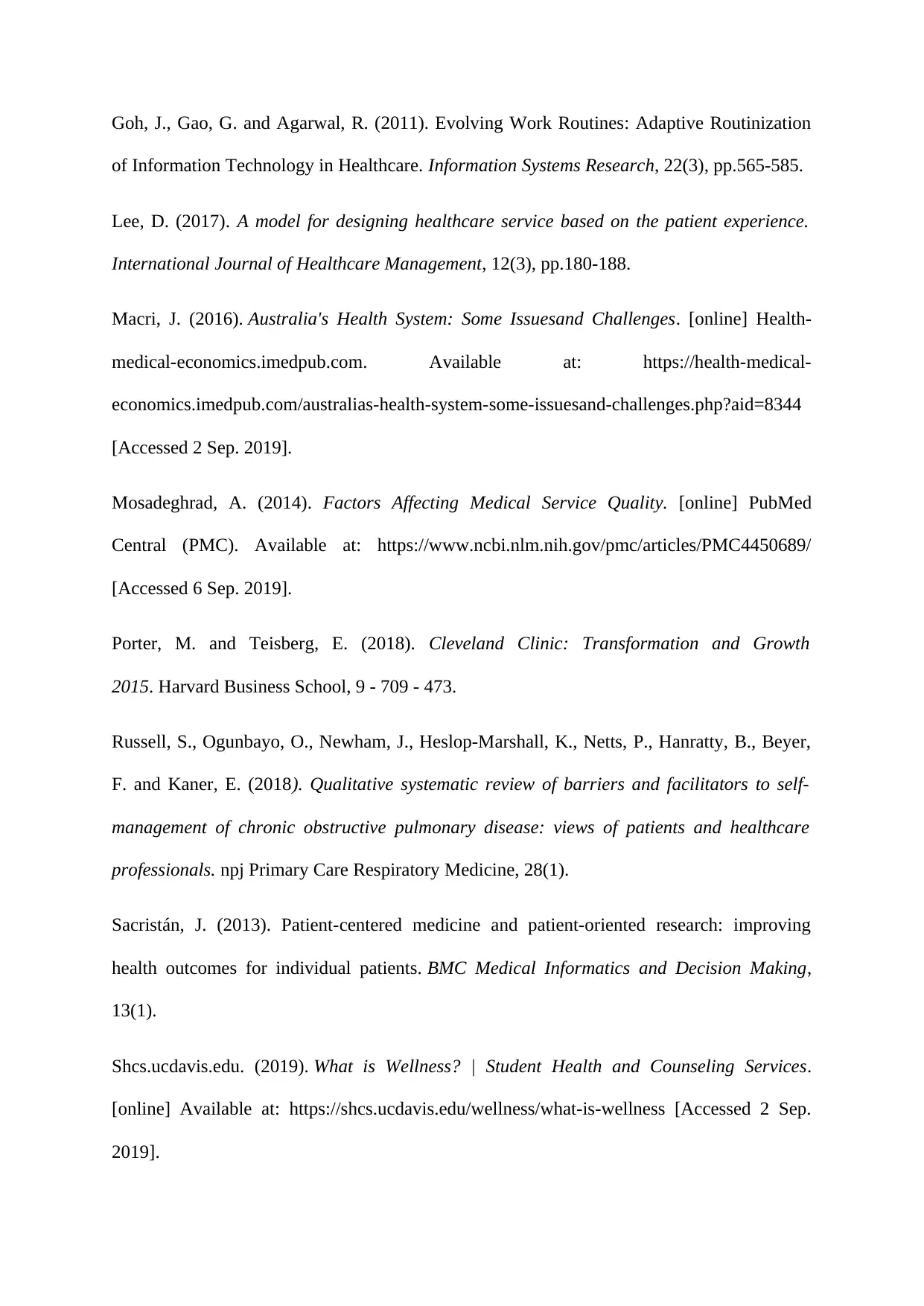
Goh, J., Gao, G. and Agarwal, R. (2011). Evolving Work Routines: Adaptive Routinization
of Information Technology in Healthcare. Information Systems Research, 22(3), pp.565-585.
Lee, D. (2017). A model for designing healthcare service based on the patient experience.
International Journal of Healthcare Management, 12(3), pp.180-188.
Macri, J. (2016). Australia's Health System: Some Issuesand Challenges. [online] Health-
medical-economics.imedpub.com. Available at: https://health-medical-
economics.imedpub.com/australias-health-system-some-issuesand-challenges.php?aid=8344
[Accessed 2 Sep. 2019].
Mosadeghrad, A. (2014). Factors Affecting Medical Service Quality. [online] PubMed
Central (PMC). Available at: https://www.ncbi.nlm.nih.gov/pmc/articles/PMC4450689/
[Accessed 6 Sep. 2019].
Porter, M. and Teisberg, E. (2018). Cleveland Clinic: Transformation and Growth
2015. Harvard Business School, 9 - 709 - 473.
Russell, S., Ogunbayo, O., Newham, J., Heslop-Marshall, K., Netts, P., Hanratty, B., Beyer,
F. and Kaner, E. (2018). Qualitative systematic review of barriers and facilitators to self-
management of chronic obstructive pulmonary disease: views of patients and healthcare
professionals. npj Primary Care Respiratory Medicine, 28(1).
Sacristán, J. (2013). Patient-centered medicine and patient-oriented research: improving
health outcomes for individual patients. BMC Medical Informatics and Decision Making,
13(1).
Shcs.ucdavis.edu. (2019). What is Wellness? | Student Health and Counseling Services.
[online] Available at: https://shcs.ucdavis.edu/wellness/what-is-wellness [Accessed 2 Sep.
2019].
of Information Technology in Healthcare. Information Systems Research, 22(3), pp.565-585.
Lee, D. (2017). A model for designing healthcare service based on the patient experience.
International Journal of Healthcare Management, 12(3), pp.180-188.
Macri, J. (2016). Australia's Health System: Some Issuesand Challenges. [online] Health-
medical-economics.imedpub.com. Available at: https://health-medical-
economics.imedpub.com/australias-health-system-some-issuesand-challenges.php?aid=8344
[Accessed 2 Sep. 2019].
Mosadeghrad, A. (2014). Factors Affecting Medical Service Quality. [online] PubMed
Central (PMC). Available at: https://www.ncbi.nlm.nih.gov/pmc/articles/PMC4450689/
[Accessed 6 Sep. 2019].
Porter, M. and Teisberg, E. (2018). Cleveland Clinic: Transformation and Growth
2015. Harvard Business School, 9 - 709 - 473.
Russell, S., Ogunbayo, O., Newham, J., Heslop-Marshall, K., Netts, P., Hanratty, B., Beyer,
F. and Kaner, E. (2018). Qualitative systematic review of barriers and facilitators to self-
management of chronic obstructive pulmonary disease: views of patients and healthcare
professionals. npj Primary Care Respiratory Medicine, 28(1).
Sacristán, J. (2013). Patient-centered medicine and patient-oriented research: improving
health outcomes for individual patients. BMC Medical Informatics and Decision Making,
13(1).
Shcs.ucdavis.edu. (2019). What is Wellness? | Student Health and Counseling Services.
[online] Available at: https://shcs.ucdavis.edu/wellness/what-is-wellness [Accessed 2 Sep.
2019].
Paraphrase This Document
Need a fresh take? Get an instant paraphrase of this document with our AI Paraphraser
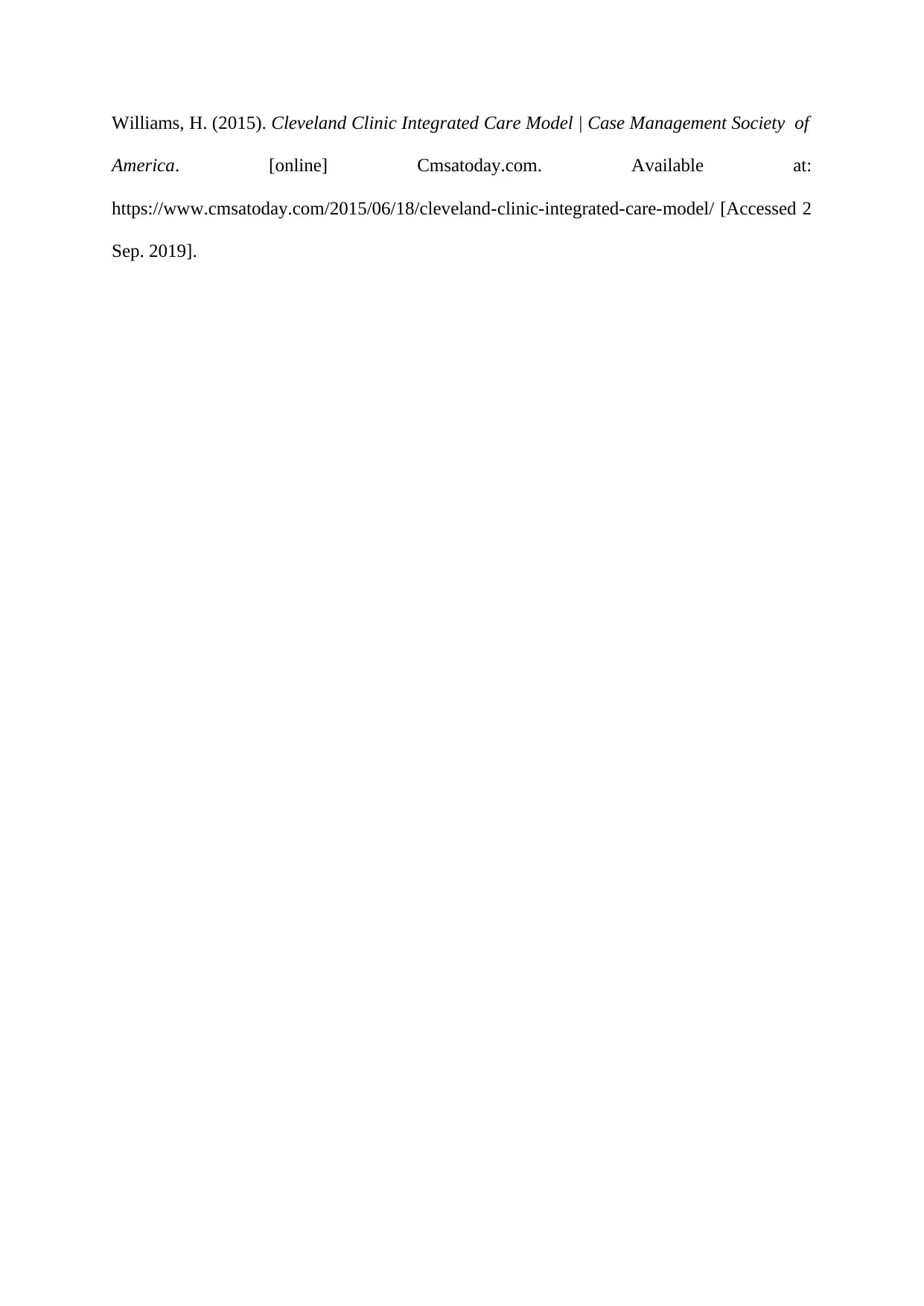
Williams, H. (2015). Cleveland Clinic Integrated Care Model | Case Management Society of
America. [online] Cmsatoday.com. Available at:
https://www.cmsatoday.com/2015/06/18/cleveland-clinic-integrated-care-model/ [Accessed 2
Sep. 2019].
America. [online] Cmsatoday.com. Available at:
https://www.cmsatoday.com/2015/06/18/cleveland-clinic-integrated-care-model/ [Accessed 2
Sep. 2019].
1 out of 11
Related Documents
Your All-in-One AI-Powered Toolkit for Academic Success.
+13062052269
info@desklib.com
Available 24*7 on WhatsApp / Email
![[object Object]](/_next/static/media/star-bottom.7253800d.svg)
Unlock your academic potential
Copyright © 2020–2025 A2Z Services. All Rights Reserved. Developed and managed by ZUCOL.




